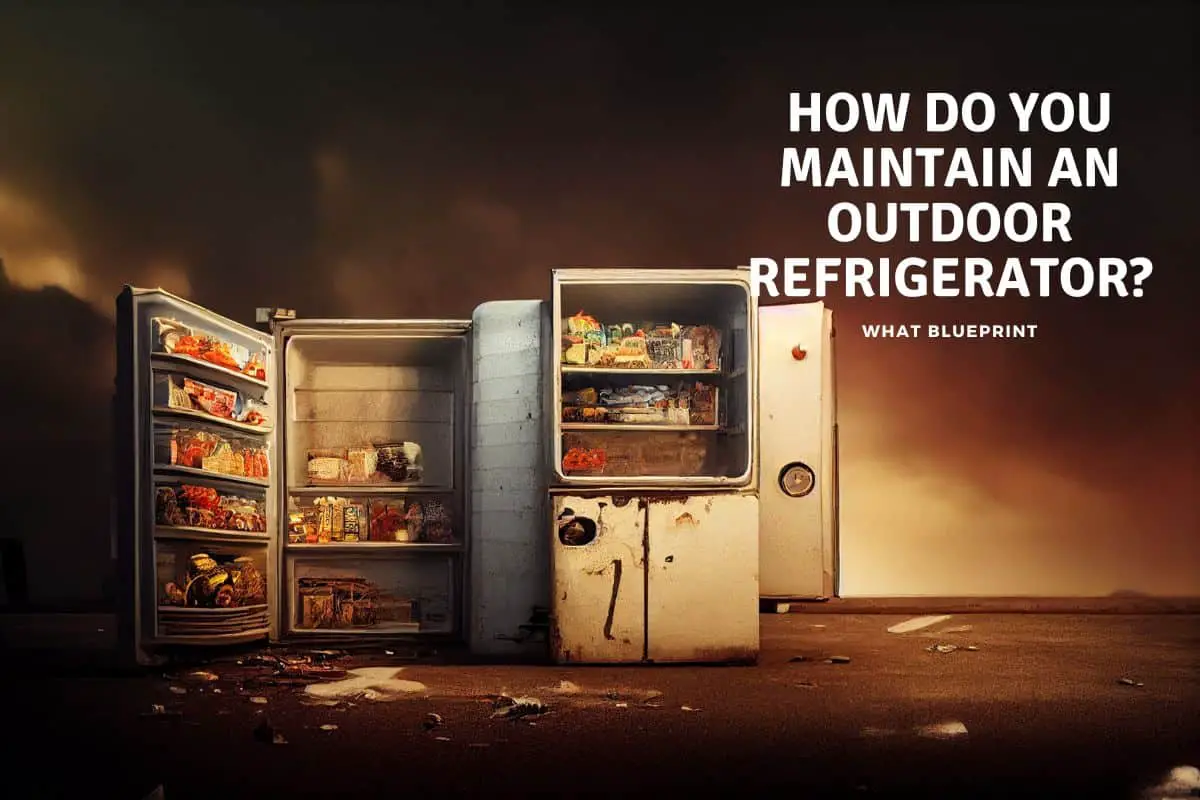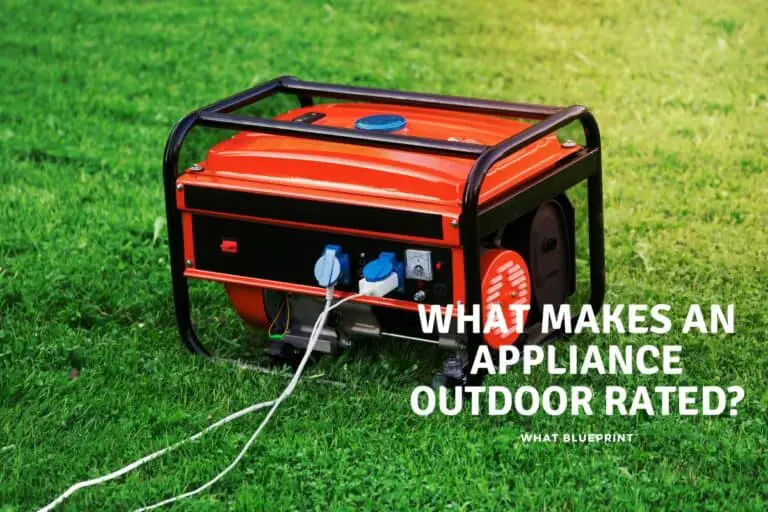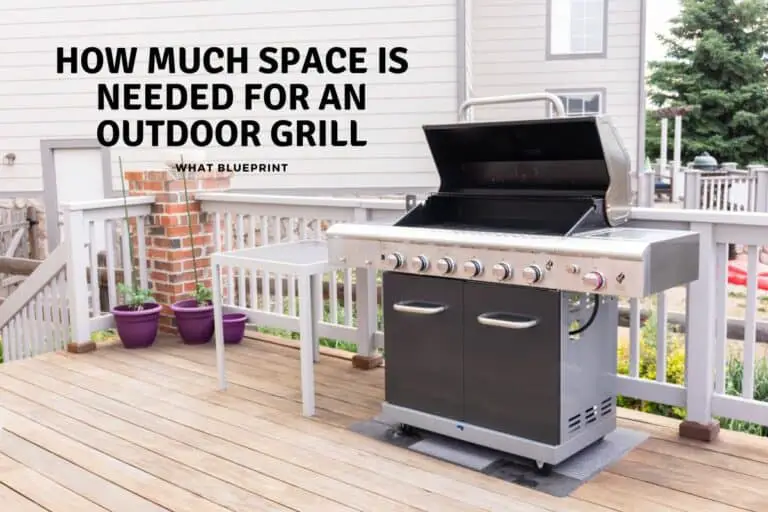How Do You Maintain An Outdoor Refrigerator?
It’s convenient to have a refrigerator in your outdoor kitchen, making entertaining a cinch. Purchasing an outdoor fridge is an investment, so you’ll want to extend its life as long as possible. How do you maintain an outdoor refrigerator?
To maintain an outdoor refrigerator, keep it cool, dry, ventilated, and clean. Regularly dust the coils, and check the gaskets, the filters, the temperature, and the light. Keep the fridge full to ensure that it functions effectively and efficiently.
If you’re contemplating putting in an outdoor fridge, you’ll want to take steps to protect the appliance from inclement weather and keep it in shape for years to come. Let’s look at some guidelines to help you maintain an outdoor refrigerator.

How To Maintain An Outdoor Refrigerator
A fridge runs continuously whatever the weather. The average lifespan of a well-maintained refrigerator is 10 to 20 years. Putting a fridge outside can shorten its lifespan if you take it for granted and don’t look after it.
Keeping your outdoor fridge in good repair doesn’t take long, and your time will be rewarded by minimizing wear and tear, saving on maintenance bills, and cutting energy costs.
We also have an article on if you can use a regular fridge outdoors, and some other options as well.
Purchase An Outdoor Unit
Upgrading your outdoor kitchen by adding a refrigerator is an excellent idea. However, no matter how regularly you perform maintenance on it, the unit will not survive if you don’t start by purchasing a refrigerator built for purpose.
Choose a refrigerator designed to function outdoors that can withstand hot, cold, wet, and dry weather. An indoor refrigerator is not built for harsh conditions, and keeping it outside will take a toll.
An outdoor refrigerator has the following characteristics:
- Compact size: The units are smaller than indoor models.
- Insulation: The fridges are better insulated to keep your food cool in the sun.
- Advanced compressors: The cooling components are more powerful and can function efficiently in the heat.
- Weatherproofing: They contain waterproof electronics so they can operate in the rain.
- Rust-resistant: The stainless steel exteriors can withstand wet and humid conditions without degrading.
- UV-protection: The shell is specially treated to be more durable and avoid sun damage.
Limit The Fridge’s Exposure
Even though outdoor fridges are hardier than indoor ones, they still can’t suffer exposure to harsh conditions. Placing your fridge in the optimal location will help to maintain it. The ideal spot is:
- Shady: Keep the fridge out of direct sunlight to reduce wear on the exterior and the cooling element. It helps to build the refrigerator into your cabinetry.
- Dry: Keep the fridge out of the way of rain, snow, and hail damage, as rust is a danger. A countertop will help, but you may also want to put the fridge on blocks or a concrete platform to avoid flooding.
- Ventilated: Ensure there is enough space around the fridge for air to circulate properly, especially if enclosed.
- Cool: Place the fridge away from the cooker, oven, or other heat-generating appliances.
- Level: If the fridge is leaning to one side, the doors may not seal properly. There will also be an additional strain on the motor. Adjust the fridge’s feet to keep it even.
Set Up A Maintenance Schedule
Maintaining your outdoor refrigerator must be a regular task. Build cleaning and repair into your weekly, monthly and annual schedule.
It’s better to prevent bacteria or mold from developing by having a cleaning and defrosting routine. Make minor repairs before problems develop that require a massive service.
Keep It Clean
Regular cleaning is the best way to maintain your outdoor refrigerator. Weekly cleaning is handy, but you’ll have to clean every three to four months thoroughly.
- Remove all debris, dust, and leaves around the unit, especially the vented area.
- Clean the outside of the fridge with warm, soapy water and a microfiber cloth to prevent a build-up of grease and grime.
- Defrost and wash down the inside compartments.
Dust The Coils
Keeping the fridge clean will extend the lifespan of the condenser coils, as they function more efficiently without an accumulation of dust.
However, you’ll need to clean the coils once or twice a year, especially if the fridge is exposed to garden debris and pet hair.
Here’s how to clean the coils of your fridge:
- Move the fridge away from the wall or cabinet to reach the coils. Moving the appliance also allows you to clean underneath and behind it.
- Unplug the refrigerator.
- Access the coils via a small grill or plate at the back or bottom of your fridge. The grill will snap off or require you to loosen a couple of screws.
- Clean the coils by running a coil-cleaning tool, stiff brush, or the vacuum cleaner’s brush attachment over and under them.
- Clean the condenser fan.
Check The Door Seal
A fridge door seals with a gasket, preventing cold air from escaping. A faulty gasket makes your fridge work harder and uses extra energy to keep cool.
If you live in a particularly humid environment, the seals can rot. An arid climate can lead to seals cracking and weathering. In both cases, you will need to perform seal maintenance more regularly.
Maintain your gasket by doing the following:
- Clean the door seal regularly with warm, soapy water. Spills and food residue harm the functioning of the seal.
- Once or twice a year, scrub the gasket with a solution of baking soda and water and an old toothbrush.
- Check the rubber seal for wear and tear. The dollar bill test lets you know if the door is loose. Close a dollar bill in the door, allowing it to stick out. If the bill slips out easily, you should check out the gasket. Other signs your seal isn’t working well are beverages not chilling, ice cream melting, and food spoiling too quickly.
- Replace the door gasket if it is cracked or perished. You can do this yourself – most hardware stores sell fridge seals – or call an expert.
- Always keep the fridge door tightly closed to maintain the temperature of your fridge.
Change The Filters
Every quarter, depending on how much you use the outdoor fridge, you should replace the filters in the ice maker and water dispenser. Dirty filters are a health hazard and reduce the efficiency of your fridge.
we have other tips and advice on all things about outdoor kitchens, you can try a search or choose from the pre selected list below.
Maintain The Temperature
Regular maintenance should include checking the temperature in the fridge and freezer. If your refrigerator isn’t functioning optimally, the unit will use more energy and be less efficient. Inconsistent or low temperatures are also a danger to food safety.
Ideally, your fridge compartment should function at 37-40⁰F (2-4⁰C). The freezer section should be at 0⁰F (-18⁰C). You can test your fridge’s temperature using a refrigerator thermometer. You will also likely notice water around the fridge as it thaws.
Maintaining the door seal and keeping the door closed will go a long way to a consistent and cold temperature in the fridge and freezer.
Keep The Light On
A working light in the fridge is convenient, as you won’t be scrabbling for items in the dark. However, ensuring that the bulb hasn’t blown is a crucial maintenance issue – the darker the fridge, the longer you will keep the door open while you search. An open fridge door lets out cold air, increases the temperature, and overworks the motor making it more difficult to maintain.
Pack The Fridge Correctly
Your fridge will be more efficient if you follow a few rules about storing food and beverages.
- No hot food: Always allow your food to cool to room temperature before storing it in the fridge. Hot items raise the fridge’s temperature, making it work harder to keep cool.
- Seal containers: Ensure that you seal your containers with lids, plastic wrap, or aluminum foil before placing them in the fridge. Open food will dry out, and the moisture that evaporates is terrible for the refrigerator.
- Keep it full: Keeping your fridge creates thermal mass, which helps the appliance operate effectively. Essentially, the more items in the refrigerator, the more warm air absorbed. A fridge or freezer that is too empty can’t function optimally, while an overcrowded fridge often blocks vents and controls, preventing air circulation.
Seasonal Maintenance
In a temperate climate, you can leave your outdoor fridge running all year round. However, if the outside temperature regularly drops below the fridge’s inner temperature, you will need to winterize your outdoor refrigerator.
To winterize and maintain your fridge:
- Switch off and unplug the refrigerator.
- Empty the fridge of all contents.
- Clean out the inside with warm, soapy water.
- Do not cover the fridge – you will trap moisture and damage the appliance. Instead, apply a coat of stainless steel finish.
- Bring the fridge inside if possible.
- Store the fridge against a wall to protect the compressor and coils.
Conclusion
Outdoor refrigerators can withstand a degree of heat, cold, and harsh weather. However, fridges aren’t all-weather appliances that you can switch on and ignore.
Taking care of your fridge will extend its life, so set up a regular maintenance routine that includes cleaning, checking, and replacing gaskets, filters, and lightbulbs and keeping the fridge correctly packed. A little thought and time to maintain your fridge can help it last years.
Resources
- https://www.ahs.com/home-matters/repair-maintenance/guide-to-refrigerator-maintenance/
- https://homeguides.sfgate.com/houseplants-repel-mosquitoes-cockroaches-pests-13771627.html
- https://www.mrappliance.com/blog/2017/may/how-to-keep-your-outdoor-appliances-safe-from-th/
- https://www.realsimple.com/home-organizing/home-improvement/maintenance-repairs/refrigerator-maintenance







